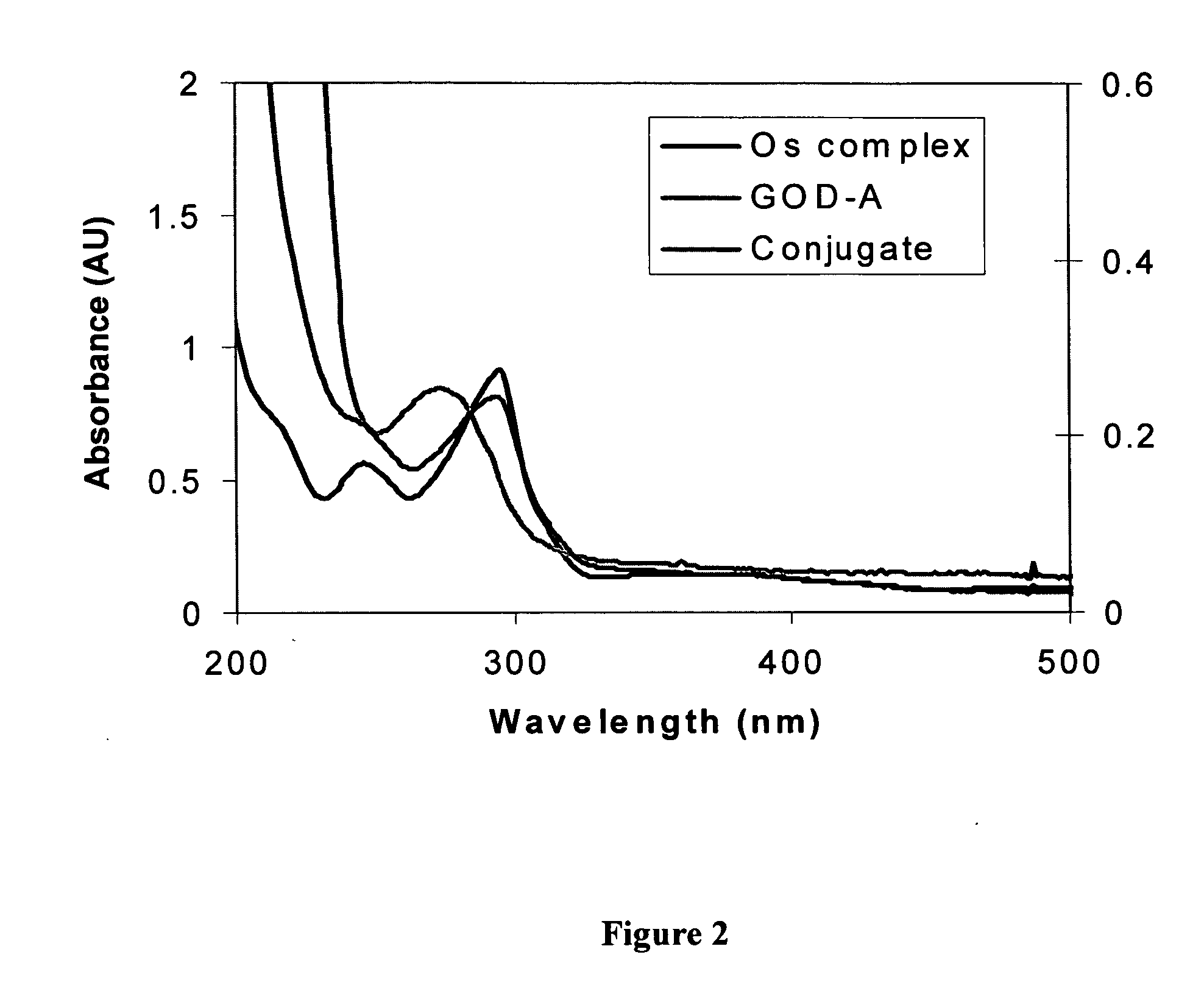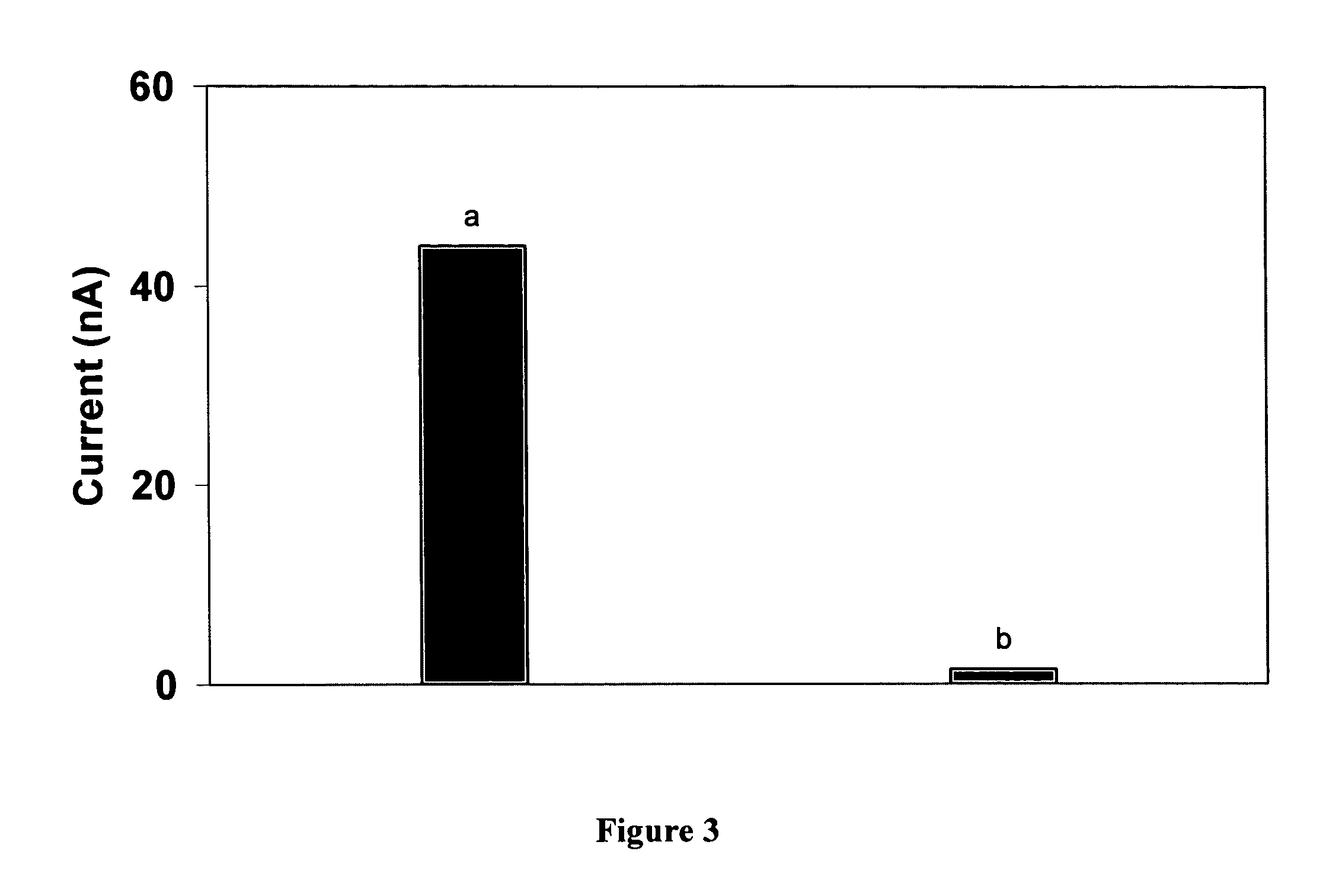Mediator-modified redox biomolecules for use in electrochemical determination of analyte
a biomolecule and electrochemical technology, applied in the field of biosensors, can solve the problems of less efficient electron transfer from redox biomolecules to the electrode surface of a biosensor than the highly efficient reduction of the natural electron acceptor
- Summary
- Abstract
- Description
- Claims
- Application Information
AI Technical Summary
Benefits of technology
Problems solved by technology
Method used
Image
Examples
example 1
[0059] This example illustrates the synthesis of the redox mediator, Os(bpy)2(3-aminopropylimidazole)Cl.
[0060] Os(bpy)2Cl2 is synthesized from K2OsCl6 (99%, Stem Chemicals) following the proposed procedure as described, for example, in Lay, P. A. et al., 1986, Inorg. Synth., 24: 291-296. Os(bpy)2(3-aminopropylimidazole)Cl is synthesized as follows: To a solution of Os(bpy)2Cl2 (0.10 mmol) in 6.0 ml fresh-distilled ethylene glycol is added 3-aminopropylimidazole (0.12 mmol) in one portions the result mixture is refluxed for 90-120 min. 3-aminopropylimidazole was purchased from Sigma-Aldrich (St. Louis, Mo.). The completion of the ligand-exchange reaction is monitored by cyclic voltammetry. The purple reaction mixture is then poured slowly into 200 ml of rapid stirred ether. The precipitate is collected by suction filtration through a fine fritted funnel. The crude product is washed with ether, dissolved in 3.0-5.0 ml of ethanol and precipitated again from ether. The precipitate is f...
example 2
[0063] This example illustrates the modification of the redox biomolecule, glucose oxidase (GOx), by coupling to a redox mediator.
[0064] Glucose oxidase-avidin D conjugate (GOx-A) (131 units / mg of solid) was purchased from Vector Laboratories (San Diego, Calif.). Glucose oxidase (GOx, EC 1.1.3.4, type X-S, from Aspergillus niger, 213 units / mg of solid) was purchased from Sigma-Aldrich (St. Louis, Mo.). 1-ethyl-3-(3-(dimethylamino)propyl)carbodiimide hydrochloride (EDC), N-hydroxysulfosuccinimide (Sulfo-NHS) and dialysis kits (MWCO 10,000) were obtained from Pierce.
[0065] GOx is covalently modified with Os(bpy)2(3-aminopropylimidazole)Cl by amide bond formation between GOx carboxylates and the aliphatic primary amino groups present on the redox mediators (e.g. transition metal compound) with EDC / NHS as coupling agent. Excess redox mediator is used to avoid protein self-crosslinking.
[0066] To 4.5 ml of 1.0 mM Os(bpy)2(3-aminopropylimidazole)Cl and 1.0 μM avidin-conjugated glucose o...
example 3
[0067] This example illustrates that the electrochemical tag of GOx modified by covalent attachment of the transition metal compound Os(bpy)2(3-aminopropylimidazole)Cl is electrochemically active.
[0068] Electrochemical experiments are carried out using a CH Instruments model 660A electrochemical workstation coupled with a low current module (CH Instruments, Austin, Tex.). The three-electrode system consists of a 2-mm-diameter gold working electrode, a miniature Ag / AgCl reference electrode (Cypress Systems, Lawrence, Kans.) and a platinum wire counter electrode. Potentials are referred to the Ag / AgCl reference electrode. Cyclic voltammetry (CV) of the electrochemical tag shows a pair of well-defined voltammetric current peaks centered at 0.19 V, showing electrochemical activity. To prove that the enzyme was indeed covalently modified, as opposed to simple electrostatic association with Os(bpy)2(3-aminopropylimidazole)Cl, a control experiment is performed according to example 2 but i...
PUM
| Property | Measurement | Unit |
|---|---|---|
| electrochemical | aaaaa | aaaaa |
| electrochemical method | aaaaa | aaaaa |
| current | aaaaa | aaaaa |
Abstract
Description
Claims
Application Information
 Login to View More
Login to View More - R&D
- Intellectual Property
- Life Sciences
- Materials
- Tech Scout
- Unparalleled Data Quality
- Higher Quality Content
- 60% Fewer Hallucinations
Browse by: Latest US Patents, China's latest patents, Technical Efficacy Thesaurus, Application Domain, Technology Topic, Popular Technical Reports.
© 2025 PatSnap. All rights reserved.Legal|Privacy policy|Modern Slavery Act Transparency Statement|Sitemap|About US| Contact US: help@patsnap.com



